Written by Zeke Perez Jr.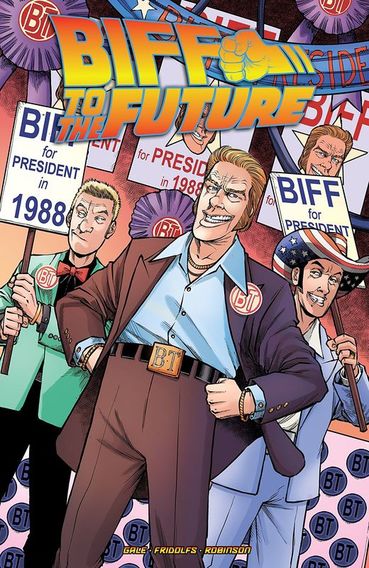 Great Scott! You missed the Biff to the Future comics as they were released?! Luckily for you, you don’t have to punch ‘January 2017’ into the time circuits of your DeLorean to go back and get them. IDW is releasing the trade paperback for the six-issue run today! If you love the Back to the Future trilogy as much as I do, you’ll want to pick it up. Biff to the Future is a tremendous addition to BTTF lore, expertly filling in the details of the 1985A or Biffhorrific timeline where Biff Tannen takes control of Hill Valley. The series is written by Derek Fridolfs and BTTF co-creator Bob Gale, with illustrations by Alan Robinson who worked on the Back to the Future: Citizen Brown comics. As is the case with other BTTF offshoots and projects, Gale’s involvement ensures its authenticity, keeping it true to the original story. But the beauty of the BTTF story - one filled with countless timelines and alternate universes shifted by even the slightest of details - is that it is so open and expansive. You can let your imagination run wild considering all the intricacies and outcomes that the movies don’t cover. In this case, the comics do a great job of enriching an already well-developed series with brilliant new ideas. Biff to the Future starts during the moment old Biff gives young Biff the infamous Grays Sports Almanac back in 1955. It follows the rise of the Tannen empire, examining how Biff used the almanac to grow his wealth, build Biff Tannen’s Pleasure Paradise (featured in Back to the Future II), and terrorize the town and the McFly family. A cast of familiar characters try to stop his evil pursuits. 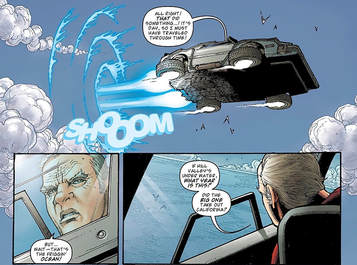 The scope of his story reaches far beyond the small Hill Valley, with implications for the United States. For instance, Biff only manages to build his casino with a little tit-for-tat favor for President Nixon, allowing gambling to be legalized in California…but only in Hill Valley. That’s just one of a handful of hilarious history-altering moments that take place. The series covers a lot of ground in just six issues, and frankly I felt like it could have gone on for a few more. Although all the loose ends are tied by the end, the conclusion in the final issue feels very rushed. Nevertheless, the buildup of Biff’s rise is perfect, teetering between humorous and dark. Most every character from the movies is seamlessly woven in. It truly feels like it could be an extended cut of the second movie. If you’re a BTTF fan, this series is a must-read. Even if you haven’t yet read the other BTTF comic series, this one stands alone and is a good, short series to start with. The second movie was great because it showed all the amazing things that the future could hold, juxtaposed against the wreckage of a Biff Tannen-centric future. With a deep storyline and Easter Eggs galore, Biff to the Future allows the reader to spend more time in 1985A; something many have longed to do. If you want to go back to that particular future right now, hurry to your local comic book shop and pick up the Biff to the Future trade paperback! Well…? What are you waiting for, butthead?!
0 Comments
Nerds That Geek Comic Book Review - 'Moon Knight' (2017) #188: 'Crazy Runs In the Family - Part 1'11/9/2017 Written by Joel T. Lewis I thought I would never love again. I had honestly convinced myself that nobody could fill the void left by the departure of Jeff Lemire and Greg Smallwood from the Moon Knight series. I was sure that no matter how good Max Bemis and Jacen Burrows’ version of the Jet and Silver Avenger was it would feel like a shadow of the former series. Now you can say what you want about Marvel misunderstanding the trends of the comic industry, you can speculate about the impact of an industry titan like Brian Michael Bendis transitioning to write for DC, you can even take issue with the whole philosophy behind the newest Marvel Legacy and Venom Universe events, but reader rest assured: when it comes to Moon Knight Marvel is firing on all cylinders. Say Anything front man and budding comic book storyteller Max Bemis and Avatar Press regular Jacen Burrows pulled off a gutsy and spectacular first issue of their ‘Crazy Runs in the Family’ arc. Bemis’ first issue focuses on the mysterious origin of the newest addition to the Moon Knight rogue’s gallery, a villain called the Sun King from the perspective of Dr. Emmet, the therapist we met in Lemire’s run. While Bemis addresses Emmet’s obsession with Spector and his unique neuroses after their interactions in the previous series, Moon Knight himself is absent from the issue and only appears in a dream sequence. Now the dream sequence is outstanding and terrifying as it depicts a horde of mummies foiled in their attempts to attack Dr. Emmet by a Moon Knight who turns out to be the Sun King in disguise, but it’s pretty risky move to open a brand new Moon Knight series without the title career appearing at all. In this case, it was a risky move that paid off. 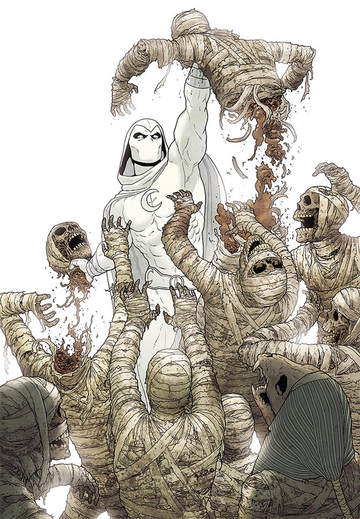 By depicting Dr. Emmet’s obsession with Spector and detailing how she uses him as a case study for trying to help her other patients, Bemis managed to put together an origin story for the Sun King that acts as a dark echo of Moon Knight’s birth. Dr. Emmet’s misguided attempt to provide her mysterious new patient with an Egyptian God metaphor to cling to as a stabilizer the way she thought Spector did with Khonshu leads to the birth of the Sun King. It’s almost the neurological equivalent of scientists trying to recreate the super soldier serum that made Steve Rogers Captain America and creating other superheroes. Emmet’s introduction of the Egyptian mythology as an anchor for her patient backfires and instead of mirroring Spector’s progress, the Sun King chooses, rather violently, a more extreme path. This is a villain origin story so well suited to Moon Knight and so unique that Moonie’s absence from the pages of the first issue doesn’t diminish it in the slightest. I have to apologize dear readers as we embark on this second Moon Knight series together because, barring some major misstep down the line, you’re going to be subjected to another series of reviews from a gushing mess of a fan boy who was lucky enough to turn his reviewer’s gaze on Moon Knight during the character’s 2nd renaissance. Bemis has thoroughly impressed me with this first issue. His writing is a delicate balance of playful and poignant handling Emmet’s practiced bedside manner skillfully in one panel, and doling out insightful interpretations of Egyptian mythology in the next. Artist Jacen Burrows is no slouch either. In this first issue Burrows presents us with his take on Khonshu, Ra, mummies, blood-stained asylum walls, Moon Knight himself, and a whole lot of fire. His work is excellent and the page-sized depiction of Moon Knight fighting off the mummies in Dr. Emmet’s dream is one of my favorite moments in Moon Knight artwork period. This is a great jumping on point for the character and I cannot recommend it enough. I can’t wait for the next issue! Until next time, Geek On! Written by Joel T. Lewis Now that we have come to the conclusion of the Jeff Lemire Moon Knight series, I am curious to see where the series will go next. With no solid plans for continuing the current run, the possibilities for the jet and silver avenger’s future are numerous. While Brian Michael Bendis has confirmed that Moonie will appear in the upcoming Defenders series (which will feature the Netflix series lineup of Jessica Jones, Luke Cage, Iron Fist, Daredevil, and the Punisher) it’s unlikely that this Moon Knight will be a continuation of Lemire’s character arc. Also, since Bendis led Moon Knight down a one-man Avengers wormhole in his 2011 Moon Knight series I’m unsure that his incorporation of Moon Knight into the Defenders will be the right fit, at least for me. That being the case, there are a number of directions that the character could go in the upcoming solo title. Marc Spector: Mercenary 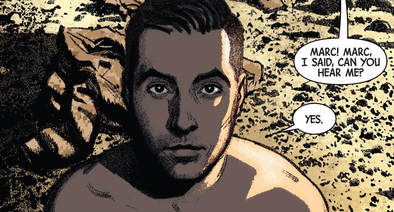 Since the outstanding 2016-17 Black Widow title has come to a close, the widely talented creative team of Mark Waid, Chris Samnee, and Matthew Wilson will potentially be available to take the reins of Moon Knight. As I mentioned in an earlier review, an interesting direction for the next Moon Knight series would be to chronicle Marc Spector and Frenchie DuChamp’s time as soldiers of fortune before Spector became Moon Knight in a series called Marc Spector: Mercenary (a call back to the 1989 Moon Knight series: Marc Spector: Moon Knight). The Black Widow team is more than capable of handling an international Black-Ops style narrative and it would be awesome to see their exceptional action panel work trained on a young Marc Spector. This would also be a great vehicle for examining DuChamp and Spector’s friendship and DuChamp’s identity, origin, and romantic feelings for Spector (we learned in the 2006 MK run by author Charlie Huston, that Frenchie identifies as a gay man and was in love with Spector for much of their friendship). This series wouldn't be retreading much ground because Lemire is really the only author to focus on this period of Moon Knight’s history and he only lingers for an issue or two so there is plenty of time to play with creatively. It would also be a great vehicle for building an international underworld where characters like Bushman, Arsenal, and Randall Spector can develop and intermingle with Frenchie and Marc. Female Representation and Moon Knight: Year One 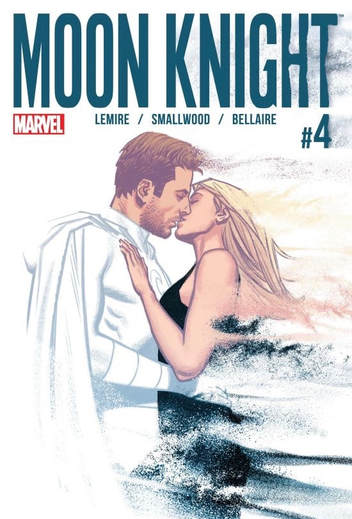 Sadly, the publication history of Moon Knight leaves much to be desired in the category of strong female characters. Gena and Marlene, who feature the most frequently, have not been developed much over the course of Moon Knight’s history. Gena is a good mother who works long hours at her diner to provide for her children, but in most appearances she trades stock dialogue with Jake Lockley and enters only to provide exposition. She is a strong single mother who owns her own business and I'd love to see some more storylines about her and her sons. But perhaps more egregious is how undeveloped Moon Knight's long-standing love-interest Marlene Alraune has been. Marlene has served as damsel-in-distress, eye-candy, and emotional stabilizer for Marc Spector throughout the history of Moon Knight comics. It is high time that she is treated to some serious character development and there are several avenues that could be explored. We never really see Marlene cope with the trauma of her father’s murder by the Bushman and a Moon Knight: Year One type series could really focus on her desire for vengeance and closure as she and Moon Knight track down Bushman. Even introducing codependency in the relationship between Marc and Marlene would give their on-again-off-again story arcs some added weight instead of inspiring repetition fatigue. Bonding them through trauma (Marc with his near-death experience and Marlene with her father’s violent death) would give their relationship a dysfunctional realism that would justify the forces that keep them together and pry them apart. Charlie Huston briefly explores Marlene’s rage and capacity for violence in issue 13 of his 2006 series and I would love to see that side of the character evolve in the future. Even on the villain side of things, Moon Knight is lacking in female representation. Bushman, Arsenal, Midnight, and Morpheus are compelling, campy, and terrifying in their own way, but one of the most underused Moon Knight villains is Stained Glass Scarlet. With a rich backstory of abuse, faith, and shifting perceptions of morality, Scarlet appeared in 12 Moon Knight issues between 1980-1998 and the crossbow-toting femme fatale hasn’t been seen since. Again, a Moon Knight: Year One would be a great showcase for this complexly motivated villain to go up against a rookie Moon Knight who’s still defining the boundaries of his vigilante justice. What If? 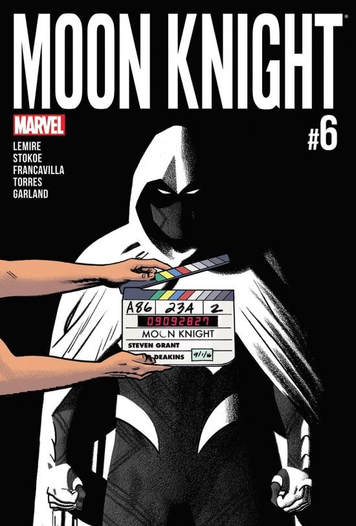 The Marvel What If series which explores alternative results to major comic events or bizarre exchanges of established character’s powers has never featured Moon Knight specifically, but there are some interesting 'What If' scenarios that would be cool new directions to explore for Moon Knight. It would be interesting to give Marc Spector a break for a bit and write an alternative history where Marlene Alraune is left for dead by Bushman in the desert wastes of Sudan and resurrected by Khonshu. Marlene Alraune: Moon Knight would be a great opportunity to rebrand the character and give Marlene some depth and development. Another rebranding direction would be to explore Raoul Bushman: Moon Knight. Ever since I read issue 6 of the 2006 Moon Knight series, I’ve been fascinated by the notion that Khonshu considered choosing the vicious Bushman as his warrior priest instead of Marc Spector. A storyline following the carnage that would follow Bushman becoming Moon Knight would be reminiscent of the Marvel Max era and could run along similar lines to what Venom has explored over the years. The greed and inhumanity that we love to hate about Bushman would clash with the desires of the Moon God and conversations between the two would be violently satisfying. Marc Spector: Space Knight 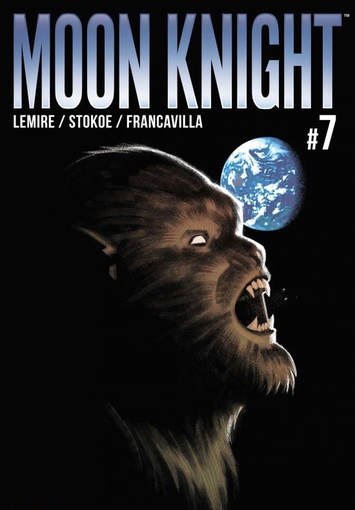 Jeff Lemire laid the groundwork for an epic Moon Knight series set in space with the Captain Marc Spector identity introduced in the 2016 run. A space Moon Knight series would be a great jumping on point for new fans, or a great continuation for fans of the most recent series and could take a primarily street-level brawler into the cosmic realm of the Marvel universe. This series, set after a Werewolf Apocalypse on earth, would make for some interesting intergalactic run-ins, maybe with the Guardians of the Galaxy or Thor and Loki. Also, this could set up some interesting storylines for Khonshu as an Othervoid creature with a cosmic history. Wherever Marvel decides to take Moon Knight in the coming months, I am along for the ride and really excited to see what comes next. Until next time, Geek On! Written by Joel T. Lewis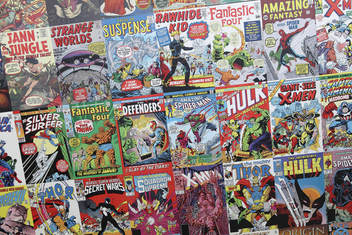 There are a lot of comics out there and honestly there’s a lot of quality storytelling going on between the pages of comic books these days. But with influx of Marvel Legacy titles (which will include the return of Moon Knight! Yay!), DC’s Dark Nights: Metal event, and the upcoming holiday season, the price of your pull-list can become too expensive to be sustainable. So as I try to reign in my Comic Budget I thought I might offer some tips to help make your own elimination process a little more bearable. 1. How quickly are you reading the comics you buy? A good gauge for the value of a comic series is how long you take to read the newest issue once you’ve bought it. Chances are if you rush home from the shop and immediately read 2 or 3 of your comics because you physically cannot wait any longer, those are the titles that should stay on your pull-list. If you find that it's been a week and you haven’t gotten around to the bulk of your titles for the week, those are the ones to cut. Also, take note of the order that you read the titles on your pull-list in. I know that when I sit down with my stack of comics I stack the beginning and end of my reading order with the titles I like the most and the middle of the road ones end up in the middle. If you’re like me and end up reading your whole pull-list the second you make it home from the Bookshop, thinking about how long it takes you to read your comics might not help much, but your reading order might. 2. Which publishers do you want to support? When I think about the comics that are important to me, the ones that I buy every month because I want to make sure they continue to be written, chances are those are not Marvel or DC titles. I try to remember that nobody’s ever going to stop putting out Batman, Iron Man, or Spider-Man titles. That is to say that for the more popular heroes and publishers, the revenue from my pull-list isn’t going to be the difference between the next arc and cancellation. When I look at the smaller publishers like Boom Studios, IDW, and Dynamite Comics those are the titles that hurt when you drop a series. That’s not to say that you should continue reading a series you don’t like just because it’s from a smaller publisher, but I like supporting the underdogs, especially when they produce quality stories. 3. Do you like the whole creative team? While I think that good writing can overcome a visual art style that doesn’t appeal to you and that good artwork can make a bland story bearable, it can be helpful to think about things you might be powering through with a certain book. Don’t feel like you have to endure a story you’re not enjoying to support an artist you like and vice versa.  4. How long is the series and how long is the current arc? Usually when I’m deciding whether or not to continue a series these factors play a huge part in my final decision. Using finite benchmarks like an individual story arc to establish a good stopping point is a great way to give a series a last chance to convince you to continue without breaking the bank with an endless commitment. Also, giving yourself till the end of the arc to decide allows you to leave the series with a bit of closure (at least narratively speaking). When you’re on the fence about continuing a mini-series (which has happened to me at least 4 times this last year) remember that because of the limited number of issues, a mini-series is easier on the wallet if you want to endure till the end but also they are usually pretty self-contained and won’t have a huge impact on the greater comic book universe if you decide to give them a miss. I’ve found that 2 issues into a mini-series you get a pretty good indication of whether you’re going to enjoy the rest of the run. 5. There’s no shame in waiting for the trade. While there is something to be said for following a series month to month and running out to get the new issue, $2.99 twice a month, or $3.99 - $4.99 a month can add up when you’re reading a lot of different series. I will always be pro-Trade Paperback. Even at full cover price, Trades are a frugal option for the avid comic book reader, that group multiple issues together at a price that works out far cheaper per issue than following monthly. Trades are great! They give you a full arc all at once, they don’t have any ads, they’re perfect for lending out to a friend, and they look great on a shelf. Waiting for Trades to be released also allows you to get a sense of the popularity of series, reading reviews and steering clear of spoilers as best you can, before picking up a series if that’s the way you buy comics. I sometimes get hung up on the cover price of Trades because they make your trips to the comic shop more expensive, but I have to remind myself that buying comics this way reduces how often I visit the comic shop. Also, Image Comics in particular are very good at making the first volume of most of their trades really reasonable, usually $9.99, which works out to less than two bucks an issue (depending on the length of the run)! 6. Marvel Unlimited Honestly, I can’t really find a way to justify buying any Marvel series month to month when Marvel Unlimited will let you read any comic they publish for ten bucks a month. But when considering Marvel Unlimited the name of the game is patience. Marvel Unlimited will allow you to read every issue that hits the shelves digitally, provided you can wait six months after they’ve been released. Now half a year is a long time to wait to start a series you know you want to read, but the value of being able to pick and choose among every series that Marvel released on that day 6 months ago, and having a huge chunk of the Marvel back-catalogue at your disposal in the meantime is a pretty compelling argument for sucking it up and waiting. Marvel Unlimited is a really cost-effective way to read comics especially when it comes to Marvel titles that you’re on the fence about. Remember, comics are awesome and collecting them is a great hobby but it doesn’t have to break the bank. Are there any titles you’re on the fence about? Do you have any elimination strategies that I didn’t mention? Please comment below or tweet me @JoelT18 on Twitter. I’d love to hear your input! Until next time, Geek On! Written by Joel T. Lewis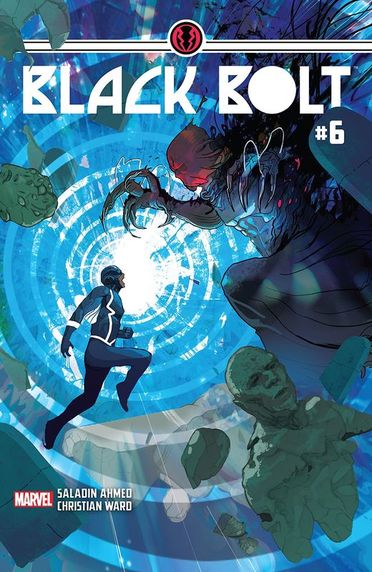 Forget that this issue of Black Bolt is the climax of a six-issue run that has made me a Black Bolt fan. Forget that this series is also responsible for my new-found love for Crusher Creel, and forget that it concludes with a more compassionately motivated title character on an interstellar journey back to earth with his all-but-adopted alien daughter Blinky by his side. This issue is all about the artwork. As if sharing pages with, and damn-near outshining, comic veteran and guest artist Frazer Irving in issue five wasn’t enough, Christian Ward’s finale work blew me away this month. Throughout this series, Ward has gotten to play in a pretty large sandbox: here’s an interstellar prison, run by an ancient Inhuman psychic vampire where he can manipulate each inmate’s reality in order to intensify the suffering that he feeds off of. Oh, and here’s a nostalgic flashback section retelling the origin of Absorbing Man. Ward is as versatile as they come but the cosmic is where he lives, bringing the bizarre world of Black Bolt’s Prison, companions, and powers to dazzling life, dripping in blues and bathed in red light. In this issue we get to see the full force of Black Bolt’s powers as our familiar ragtag team of misfits confront the parasitic Jailer one last time, and in a series defined by excellent color work, Ward outdoes himself. I suppose I should have seen (Spoiler Upcoming) that Saladin Ahmed’s heartfelt tribute and character arc for Crusher Creel in this series was setting the B-lister up for a noble sacrifice but I didn’t and it hit me pretty hard. But what a way to go out! Realizing that none of their powers were able to effect the Jailer from behind Black Bolt’s shield, Creel decides to sacrifice himself for the good of his fellow inmates. He tells Blinky to use her telepathic powers to lure the Jailer into feeding off of his mind, but before that he tells Black Bolt to yell at him. Bolt, knowing that there is no other way, wails with all of his might at Creel and the Absorbing Man does what he does best and becomes the physical embodiment of Black Bolt’s scream. Luminous, saddened, but determined Crusher flies at the Jailer and sends him into oblivion in a sea of technicolor carnage that contrasts beautifully with the red-lit panels of the previous pages. This first arc of the Black Bolt series has come to a sad but satisfying conclusion as the deposed King of the Inhumans can now begin the long journey across the stars to retake his throne and reunite with his people. As each of the ragtag team bids the silent King farewell he is faced with a complicated decision: what’s to be done with Blinky? Here is where we really see the development that author Saladin Ahmed has weaved into Black Bolt’s character. Instead of a cold monarch’s decree that the child will have to return to her world, where she would be put to death, Black Bolt responds with a newfound softness, smiling quietly, saying yes. This first arc has been emotional, stunning, and terrifying. Marvel really has hooked into something special with the combination of Saladin Ahmed and Christian Ward and I’m thrilled to have been able to follow this series from its inception. To take the prison break trope and breathe such vibrant new life into it is really impressive and Ahmed pulled it off flawlessly. I cannot wait to see where this series goes next. I’ve seen some pretty exciting sneak peek posts from artist Frazer Irving who will be returning to the title and it will be a really interesting dynamic to see a storyline where Black Bolt and Blinky journey across the stars headed for Earth. I love Blinky and I’m so happy to see her story continue and maybe she’ll cross paths with Moon Girl and Devil Dinosaur soon! Are you enjoying Black Bolt? What are your thoughts on Absorbing Man? Please comment below or shoot me a message on Twitter @Joelt18. Until next time, Geek On! Written by Joel T. Lewis 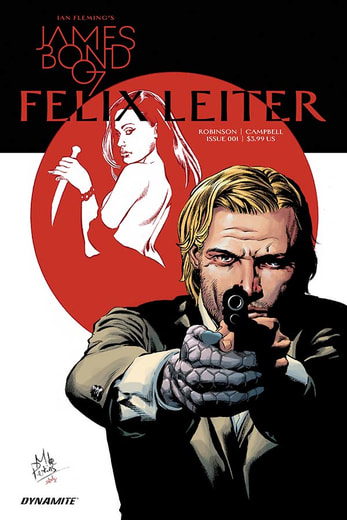 I didn’t get what I wanted from Dynamite’s Felix Leiter series. I wanted a series that showed that Leiter was every inch the American counterpart to James Bond. A competent, calculating, international man of mystery who orders Jack Daniels in the lobbies of exorbitant hotels because that’s what an American would do. This isn’t author James Robinson’s Felix Leiter. It is isn’t what I wanted. I got something better. Felix isn’t James Bond. He’s never been James Bond and the humanity author James Robinson contributes to the arc of a man constantly on the sidelines in Bond’s adventures is uplifting in a strange sad way. Maimed and no longer a member of the CIA, Leiter teams up with Japan’s super spy Tiger Tanaka on a straightforward mission, ID-ing a Russian spook whose history with Leiter went beyond professional admiration. At least on Leiter’s side. This seemingly simple recon mission expands into a conspiracy to start a war between North Korea and Japan. The method? Weaponized radical cultists who disintegrate and massacre everyone within breathing range. First of all, what a pairing! You Only Live Twice’s ninja-spy Tiger Tanaka and the CIA’s own Felix Leiter? Talk about two for one. Tiger is every bit the badass we got to see in the fourth Bond film. With his elite team of ninjas, Tanaka’s bold and decisive strikes as a leader and later as an operative himself are really satisfying to read. With a gun or katana, Tiger is a formidable agent who rivals James Bond’s innovation and brutality. In the middle of Tokyo’s vibrant Metropolis or the dead of night overlooking a private army’s compound, the Leiter series’ artwork leaps off every page. With lines and color conveying the noise or silence of Leiter’s surroundings, artist Aaron Campbell and Colorist Salvatore Aila execute each panel to perfection. With the ability to convey the size and scale of sweeping landscapes and the claustrophobia of hand to hand combat, Campbell and Aila make reading their series breathtaking and cinematic capturing intimacy and scale exceptionally. 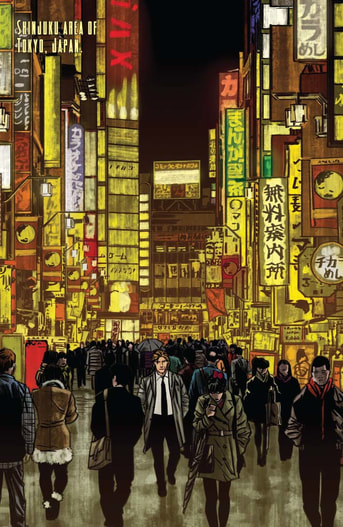 But this 6 issue series (please Dynamite let there be more) really shines as a showcase for the sometimes bumbling Felix Leiter. Robbed of his right forearm and left leg (replaced by Bond-Villain level prosthetics), Leiter expresses his feelings of inadequacy when compared to the mighty Tanaka or the indestructible 007 throughout the series and you follow the arc of a man struggling for confidence and relevancy. And who wouldn’t question their worth surrounded by supermen like Tanaka and Bond who seem to artfully handle everything thrown at them and manage to walk away unscathed? Especially, as a man who bears the scars of missions past? Having led from the rear for much of his career, Leiter forces himself to take charge and infiltrates the web of intrigue surrounding the impending conflict between North Korea and Japan helped by Tanaka. Falling, dropping his gun, and even getting caught with an unloaded weapon at one point, Leiter’s spirit and determination move the plot of the series and you find it hard not to root for him. But your identification with his character doesn't come from a place of pity. It would have been all too easy for Robinson to lean into the maimed operative trope and make Felix tragic and pitiful, but at no point does Felix feel sorry for himself. He has a self-awareness of his limitations and where he stacks up next to Tanaka and Bond as an operative, but also the drive and desire to push those boundaries. This determination is especially evident in the climatic sequence toward the end of the series where Felix doesn't think and just reacts, taking out operatives in rough and tumble fashion that would do 007 proud. Leiter is in many ways the inverse of James Bond. He expresses lingering feelings for the Russian agent he's been sent to ID in a way that Bond never would, he doubts, he despairs, but he doesn't let any of his shortcomings prevent him from trying. Leiter also shines as a counterweight to the passionate rage of Tiger after a fatal misstep in the apprehension of a cult leader causes the majority of his personnel to perish. The American’s level-headedness allows Tanaka to clear his head and Leiter’s diligent surveillance work leads to a critical revelation about the forces behind the biological attacks. It's odd to think that the only Dynamite Bond titles I've read so far have been about supporting characters and I've yet to read any of those starring the man himself. If the Moneypenny one-shot and this Felix Leiter series are any indication, Dynamite comics have tapped into everything fun and compelling about the Bond films and the Bond expanded universe could not be in more capable hands. Until next time, Geek On! Written by Joel T. Lewis 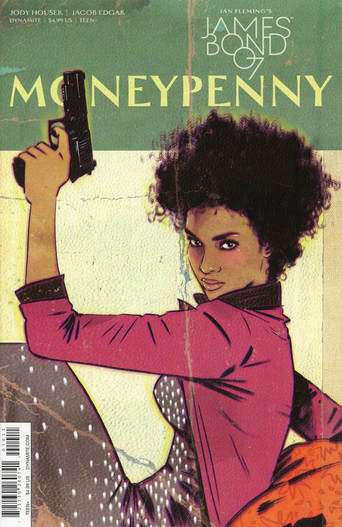 As a massive James Bond fan, I’ve had the misfortune of remembering that Dynamite comics have been producing a handful of Bond Comics too late to follow them month to month. So, I have had to watch as issues of James Bond: Black Box, Kill Chain, Hammerhead, and Felix Leiter have come and gone and wait patiently for the trades to be released and the funds to invest in them. Missing out on the Felix Leiter series was particularly painful as I have a fond affection for the sometimes bumbling CIA agent. So, when I discovered in advance that there was going to be a Moneypenny one-shot, I was ecstatic and it was instantly added to my pull-list. If anybody affiliated with Dynamite Comics happens to be reading this, please give our girl a full-on series, because she kicks some major ass in this one-shot. Jody Houser’s one-shot does a great job balancing a fragmented origin story for Moneypenny with a present-day narrative describing her first security detail assignment after leaving field work. One of the most poignant flashbacks in this issue dealt with one of Moneypenny’s first memories of prejudice. After a group of bullies, led by a blonde-haired blue-eyed girl, at her primary school harass one of her middle-eastern school mates, implying that all people from that area are potential terrorists, Moneypenny’s attempt to comfort her friend has an unexpected response. In the girl’s bathroom later, Moneypenny asserts that the recent terror attacks that have gotten everyone up in arms have nothing to do with her friend or her family. Her friend responds passionately as she storms past, ‘I know that. I'm not the one you needed to say that to.’ It is a nuanced and powerful point that Jody Hauser makes about the power and context of words and the proper venues and strategies for standing up for the persecuted. By comforting her friend after the fact, Moneypenny acted out of compassion, but from a position of comfort (behind the closed doors of the girl's bathroom). But if she had stood up to the group of bullies as they were being cruel, the vulnerability of that position would have been a real testament to the ally Moneypenny was trying to be. This early experience shapes Moneypenny into a powerful and unapologetic adult, who does not bend towards convention and refuses to suffer bigotry. Moneypenny demonstrates this firm stance as a powerful woman of color as she calls out her the male members of her team for their misogynist and condescending statements about her refusal to join them for a drink on the job. The creative combination of colorist Dearbhla Kelly and artist Jacob Edgar showcase just how no-nonsense Moneypenny is as an operative. The way she views the world around her informs our perception of her as a highly skilled agent. Contrasting the location of exits, weapons, and tools with shades of red set against cooler tones of bluish greens to indicate neutral spaces in rooms, Kelly and Edgar show that whenever Moneypenny enters a room, she's instantly aware of the best object to use as a weapon and the quickest escape route. Though her reassignment from straight field work to head of security detail seems to irk Moneypenny, the man she is assigned to guard assures her of her worth and competence and the tired trope of ‘undervalued agent lowered to babysitting’ is quickly disarmed. Moneypenny takes this new assignment very seriously, and it's a good thing too. Following a speech by the man her subject traveled to see, Moneypenny notices an eerie absence of students moving about on the college campus and proceeds to dismantle a large team of operatives aiming to kill her subject. I don't want to go into too much detail about this powerhouse sequence at the end of this issue but I will say that this creative team shows Moneypenny to be every bit as competent, efficient, and clever an operative as James Bond and don't forget: she's doing it all in heels! Comics need more strong bad-ass women of color as their focus, and Moneypenny is a great example of a character who can carry her own series in a universe dominated by male agents. Move over James, it's Moneypenny’s turn! Until next time, Geek On! Written by Joel T. Lewis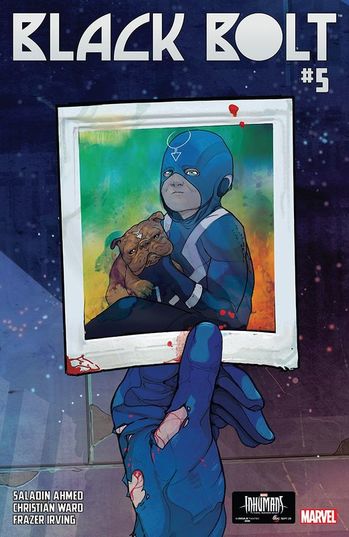 This issue of Black Bolt began with a response to the brilliantly retold Absorbing Man origin story in issue 4. Over the course of the first 4 pages, guest Artist Frazer Irving retells Black Bolt’s origin story from the point of view of his faithful pup Lockjaw. Irving’s style and texture is a great contrast and complement to the sleek polish of Christian Ward who illustrates the rest of the issue. As he depicts the classic tale of the Inhuman Prince and his teleporting dog, Irving’s panels are gorgeous. My favorite panel in these early pages is one showing Lockjaw flanked by Black Bolt, Ben Grim, and a fiery Johnny Storm. These quick snapshots of Black Bolt’s past accomplish two goals: one, they are a great recap of the Black Bolt Origin for somebody new to the character, and two, they firmly establish the special bond between the silent King and his massive pooch. As the artistic reins are handed back to Christian Ward we find Black Bolt finally freed thanks to his faithful pup. As his power returns, Black Bolt is torn over his next steps. Usurped and betrayed by his brother Maximus the Mad, Bolt wishes to return to Earth in order to expose the cruel farce his brother has been playing out posing as the king of the Inhumans. However, because of the bonds he has formed with his fellow inmates in that cosmic nightmare of a prison, and his faith in his wife Medusa’s ability to handle Maximus, Black Bolt decides to return to rescue his friends. After freeing Crusher Creel, Blinky, Metal Master, and Raava and capturing the vile guard Spyder, Black Bolt charges ahead to confront the powerful telepath at the center of the prison, the Jailer. Spyder manages to spring a trap and in the process, seriously injures Lockjaw. Amid a spectacular two-page spread of wild combat and action demonstrating the power of each of the former captives, Black Bolt unleashes his full power against Spyder, disintegrating him. Do not mess with Black Bolt’s pup. In order to end the madness of the cruel prison, the company must leave the wounded Lockjaw behind and they discover another layer to the mystery of the Jailer. 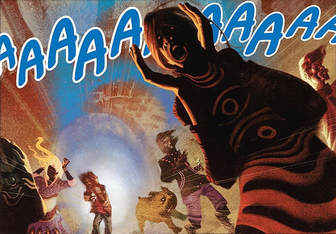 The first inmate of the prison they have come to despise was in fact their Jailer. A telepathic vampire who regained his powers and was able to feed on the villains of the cosmos for centuries undiscovered, the Jailer unleashes one last defense before the conclusion of the issue. The group of former inmates turn around to discover a shimmering legion of ghosts. The ghosts of their loved ones. The angry ghosts of their loved ones. Saladin Ahmed is doing a spectacular job of making one of the most stoic and inaccessible figures in Marvel Comics into someone you can instantly relate to and want to root for. It’s not just that he has a comically large dog, it’s not just that that comically large dog is instantly and forever loyal to him, but it might be that the juxtaposition of that silly, slobbering pup and the joy he inspires from a stern serious figure like Black Bolt that gives this issue, and by extension Black Bolt, such charm. The additional artistic support of Irving in no way confuses or diminishes Ward’s ability to light up every panel he touches. A particularly spectacular panel depicts Crusher Creel after he absorbs one of the prison’s containment devices. For a character whose costume consists of not wearing a shirt, as Black Bolt pointed out last issue, the versatility of what Creel absorbs is where the artist truly shines. Liquid blue punctuated with streaks of eerie pink is a good look for Creel and Ward’s design is impressive. I can't wait for issue 6 when Black Bolt comes face to face with the parents he accidentally murdered as a baby. Until next time, Geek On! Written by Joel T. Lewis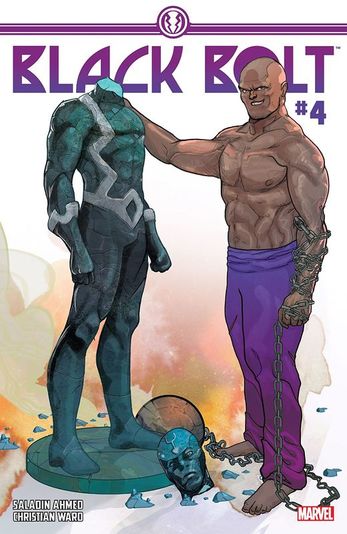 One of the things I love about comics is the unending amount of intercontextuality within the universes. Absorbing Man Carl ‘Crusher’ Creel has been a part of the Marvel Universe since 1965. With numerous appearances of varying significance, one could trace his character arc from his first appearance in Journey into Mystery #114 to the present day. This is the case for basically all of comic book characters, but there has to be some motivation for tracking down and deeply immersing yourself in a character who may not be on the A-list of villains. The great thing about comics is that the stories that spark that obsessive motivation, those issues that reshape a character’s value in your mind, come more often than you might think. Crusher Creel is one of those characters and Black Bolt #4 is one of those issues. The opening page of this issue is one of the most succinct and successful recaps I’ve ever seen in comics as Author Saladin Ahmed and Artist Christian Ward drive home the events that have led up to Black Bolt’s most recent predicament with brevity and minimalism. In panels that dwindle in size, ward portrays the downward spiral of Black Bolt’s life to the current moment, where we find him and Crusher Creel trapped in a chamber where Jailer is slowly pumping out all the oxygen. Unable to escape from their bonds, Crusher resolves not to die in silence, an ironic and poignant decision the effect of which is not lost on Black Bolt, a man who has spent most of his life in silence. Creel imparts his life’s story to Black Bolt in a beautifully executed montage of color, style, and prose as both Ward and Ahmed make you fall in love with Creel as they play with the B-List villain’s origin. Take a broken home, an abusive father, a passionate boxer, a lower level enforcer, then add a magic potion and that’s how you get the Absorbing Man, and while the progression of Creel from well-meaning youth to Thor-Smashing B-Lister isn’t too innovative, the way Ward portrays it is. The collage of heroes, villains, and flashbacks contained within this issue could pass as a professional artist’s portfolio as Ward slips effortlessly from style to style, masterfully matching color to concept and executing the nostalgia and emotional weight of each panel with precision. It really is an issue you have to see to believe, and it marks a great jumping-on point for this series, which is unique for the fourth issue in a series. I would be doing this issue’s architects a disservice if I didn’t mention how perfectly this issue’s cover art captures the spirit of what goes on between the pages. Through the heartfelt vulnerability that Creel shows in his revelations to Black Bolt, Bolt himself is laid bare and vulnerable and the stony facade of the silent Inhuman King comes crumbling down around a very hurt and sensitive being. What a great way to make a classically stoic and alien figure like Black Bolt relatable and engaging. This near-death heart-to-heart shared by these two men is beautiful and has made me love both characters all the more for it. We even get to see Black Bolt laugh! Just moments before all of the oxygen is removed from the cell, Creel gives Bolt a cheesy one-liner joke and the two share such a pure moment of laughter. Both men, exposed and vulnerable prepare for their last moments when suddenly Lockjaw, Black Bolt’s teleporting pup, appears and whisks Bolt away. Creel is left alone and we are left to wonder if Bolt will return to rescue his unlikely friend. This issue was special. This series is special. This creative team is wildly talented and I cannot wait to see what they do in issue 5. Until next time, Geek On! Written by Joel T. Lewis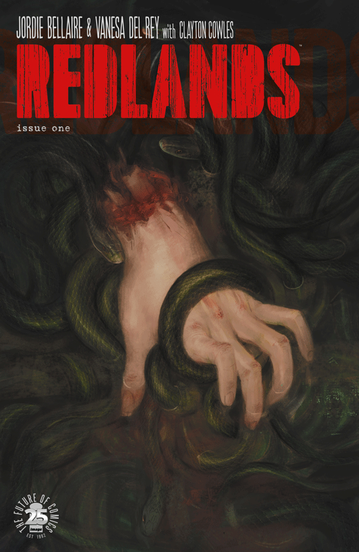 The ‘victims’ of violence in Redlands number 1, set in 1977 Redlands, Florida are sexists, racists, and murderers. And what colorist extraordinaire (and now author) Jordie Bellaire and artist Vanesa Del Rey do to these pillars of white supremacy and the patriarchy via their three Witch protagonists is just about the most violent, terrifying, and vibrant carnage I've seen between the covers of a comic book. And it's damn satisfying. If you read comics even causally, chances are that you've seen the name Jordie Bellaire more than once. Jordie is one of the comic book industry's most talented colorists whose credits include Injection, The Punisher, Batman, Moon Knight, and Vision to name just a few. Regardless of the artist, or publisher for that matter, Bellaire elevates the comics she contributes to with a particular eye for shadow and textures. In her debut as a comic book writer, Jordie Bellaire begins Redlands issue 1 with a group of bigoted cops barricaded within their police station, watching in disbelief as the tree they tried to lynch our mysterious Witch protagonists from is engulfed in flame, and the would-be hang-ees are nowhere to be found. It's unclear what led to their attempted lynching or how they came to visit Redlands in the first place, but it becomes apparent very quickly that however monstrous the witches might be, the true villains of this story are the policemen. From the confederate flag flying in the background of the police station, to the racist and rape-culture rhetoric spouted by the Sheriff and his son, Bellaire quickly sets up a clever dichotomy of monstrous figures: the bigoted police force of 1977 (and there are clear hints that we may not have moved too far away from that type of bigotry in the modern day) and the horrific specters that terrorize them. The home invasion style horror narrative wastes no time in splattering blood all over the panels as the first police causality is decapitated rather gruesomely by a black wisp of shadow. This officer, dying while ushering a mysterious child inside the walls of the police station, thuds to the ground and the police rush to more thoroughly barricade the doors. The Sheriff, in response to his confused son’s questions about what to do, crunches the butt of his shotgun into his face. While this first impression of the Sheriff is by no means the vilest, it does a great job of showcasing this character's lack of compassion. Sent to check on the delinquent occupants of the station’s holding cell, the Sheriff's son proceeds to demonstrate serious prejudice against the people of color behind bars and casually refers to sexually assaulting women. Needless to say, as a reader at this point in the issue I was onboard with whatever messy end Bellaire had in store for these guys. 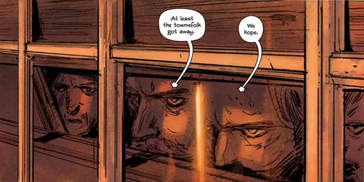 We then discover that the mysterious child who the police let inside the station is not what she appears as she twists and shifts among the shadows into a creature like a Minotaur and then into a terrifying banshee creature. In the confusion and violence caused by the mysterious child, the Sheriff's son finds himself outside taken hostage by another specter. The Sheriff, in an attempt to save his boy (whose nose he shattered just a few short pages ago) fires at the new specter, misses, and ends up killing his son instead. The razor sharp shadow, the empty nooses hanging from the tree outside the station, the shapeshifting child, and the three Witches we meet at the end of the issue are haunting and executed brilliantly by artist Vanesa Del Rey. One of my favorite visual elements of this issue was Del Rey’s beautiful and eerie moth who overhears the police’s sexual assault rhetoric. The detail and precision of Del Rey’s work is outstanding and the moth reminded me of the larger part those creatures played in my favorite thriller, The Silence of the Lambs. But where this book really stands out (appropriately) is in Bellaire’s masterful color work. Shadow, firelight, carnage, and gore are all brought to vivid life by one of the most prolific and talented colorists in comics today. It is Bellaire’s skill and use of shadow that allows the horror of this comic to succeed. By drenching her shape shifting child character in the right light, the terror you feel when you see her true form is made all the more dramatic. Fire burns brighter, blood shines redder, and shadow looms more ominous because of Bellaire’s mastery of color. There’s not much more to sum up in terms of plot for this first issue. Suffice it to say that a trio of Witches enact some gruesome, but righteous, violence on a group of bigots and I thoroughly enjoyed the ride. Horror is a great genre for critiquing injustice and bigotry as fear and cruelty can be applied to supernatural elements of fiction, as well as prejudice and supremacy in real life and Bellaire's narrative is fearless in its commentary on fear. This is a mature comic, and an important one. I cannot wait for issue 2 and I’m happy to have gotten in on the ground floor of what promises to be the long and illustrious career of Jordie Bellaire the author. Until next time, Geek On! |
Archives
May 2024
|
|
© 2012-2025, Nerds That Geek LLC.
All Rights Reserved. |
uWeb Hosting by FatCow
